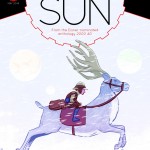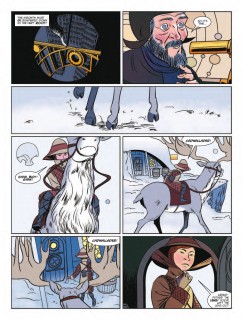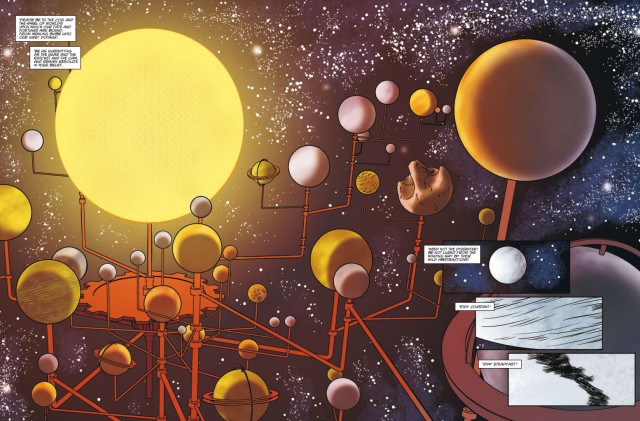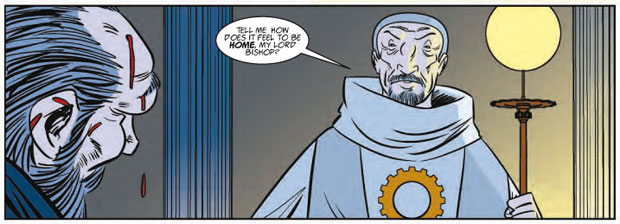“I vent my spleen on the Swiftian absurdity of politics and the inbred nepotism of monarchy!” Ian Edginton talks clockwork planets and heretical bishops in new series Brass Sun from 2000 AD
 At the centre of the world of Brass Sun is the Orrery a vast clockwork solar system where planets whirl on vast metal arms and the sun of cogs is worshipped as a god. This new mini series from 2000 AD writer Ian Edginton and artist INJ Culbard is released on May 28th by 2000 AD/Rebellion Publishing and sees heroine Wren look to save her home world, and in turn the entire universe, from heretical cog worshipping bishops and along the way set out on a mission to restart the sun! No small scale story-telling here! To find out more about this mix of fairy tale, steam punk, clock punk and good old fashioned science fantasy we contacted writer Ian Edginton to ask what it would be like living in a clockwork world.
At the centre of the world of Brass Sun is the Orrery a vast clockwork solar system where planets whirl on vast metal arms and the sun of cogs is worshipped as a god. This new mini series from 2000 AD writer Ian Edginton and artist INJ Culbard is released on May 28th by 2000 AD/Rebellion Publishing and sees heroine Wren look to save her home world, and in turn the entire universe, from heretical cog worshipping bishops and along the way set out on a mission to restart the sun! No small scale story-telling here! To find out more about this mix of fairy tale, steam punk, clock punk and good old fashioned science fantasy we contacted writer Ian Edginton to ask what it would be like living in a clockwork world.
Tell us a bit about the inspiration for Brass Sun – I’m assuming the idea of a world within a revolving set of clockwork planets must have been a key starting point? But how did the story evolve from there?
IE: It was one of those blindingly obvious ‘why didn’t I think of it before’ moments. I was looking for a good image of an orrery for a story I was working when it struck me, wouldn’t it be great if these things were full size? If they were real? And that was it. The other story got put in the drawer and what was to be Brass Sun was born. It wasn’t something I could have filed away for later either. Once I started thinking of it and working it through, I had to keep going, the ideas just kept on popping like Whack-a-mole! I love world building and I’d just given myself an entire solar system to play with.

How important was it for you to have a female protagonist? It often seems that in stories of this nature a female lead works better, but was it a conscious choice?
IE: It wasn’t done in a self conscious, politically correct, positive discrimination kind of way. I was raised by two women, my mother and grandmother. I have a wife and two daughters. Women are everywhere! So the decision to make the lead female was simply – why not? I wanted something my daughters could pick up and see a girl as the hero, but also feel that it isn’t exceptional, it’s just the way it should be.
I’ve done a number of interviews for Brass Sun and The Hinterkind, my Vertigo book (which also has a female protagonist) and the same question always arises – why did you choose to have a female lead? It’s as if it was a curious choice to make, or something that needed to be justified. It’s very strange.
The most important criteria is character. It doesn’t matter if your lead (male or female) is awesome and kick ass. If there’s nothing else about them to engage you, then you’re going to lose interest pretty quickly.
Everything in Brass Sun feels very carefully considered and precise – as you would expect in a clock punk story I guess – how important is world building in a title like Brass Sun? Is it essential to work out the finer details before you start scripting and drawing or do you find things evolve naturally as you go along?
IE: A little from column A and a little from column B. When I was putting the overview and outline together I compiled a comprehensive list of all the exotic worlds that we’ll see in the Orrery at some point. For example, there are brick moons, ocean and jungle worlds, factory planets, gas giants that are farmed for their fuel. Then there’s the world of The Keep which comprises a single landmass that’s actually an enormous palace along the lines of Mervyn Peake’s Gormenghast. That sort of thing.
Ian and I also decided that when I came to showing the Orrery we’d include extra worlds but we didn’t know what would be on them. We wanted to have spares for when we came up with other ideas later on. So there’s a degree of us just winging it there too!

IE: Ian and I bounce ideas around all the time. We pull in influences from all over whether it’s art, architecture, history or films. We try and give each world it’s own visual theme and style so you can differentiate it from the others. We’re not too worried about accuracy, it’s more about catching a mood and a strong visual narrative. For me personally, it all has the feel of the early Terry Gilliam movies such as Time Bandits, Brazil and Baron Munchausen. Also the work of Jean-Pierre Jeunet and Marc Caro especially Delicatessen and The City of Lost Children.
Religion and the idea of faith is clearly a central part of the story, is it intended as a satire of organised religion or do you just use the conventions as a way to advance the story? The idea of a retired bishop being branded a heretic feels like a very powerful story line to explore, I presume the archimandrate (Eusabius’ replacement?) and co will be a continuing source of antagonism in the series?
IE: We will be coming back to Wren’s home world of Hind Leg, where the Archimandrite rules supreme but it won’t be for a very long time.
I don’t have a problem with people having a faith. I don’t understand it sometimes though, especially when it runs counter to logic. What I despise, is the dogma, the hypocrisy, the prejudice, the oppression of free-will and the abuse of power. In Brass Sun, I vent my spleen not only on religion but the Swiftian absurdity of politics and the inbred nepotism of monarchy. It’s a fun ride!

I love the contrast between the mechanised world and the soft countryside (with an almost Nordic feel to it) of Wren and her grandfather. Was that a specific choice to contrast it so heavily?
IE: Each of the worlds in the Orrery has their own look and personality.
I like Hind Leg (Wren’s world), I love the chilly isolation, but the story has to move along so we don’t hang around there too long.
You’ve set out quite an epic scale for the world and for the story to work in? I’m presuming Brass Sun will develop into being an ongoing series do you have an overall plan of where you would like the story to head?
IE: Yes, Brass Sun is on-going, as much as these things ever are. Wren’s story does have a definite end and I know what it is. We’re going to take a while getting there though. Along the way we meet an extraordinary cast of characters and they’ll have their own tales to tell.
Finally, do you consider Brass Sun to be a work of ‘clock punk’? If so, what draws you to that sub-genre and how do you feel about your work being categorised in such a way? If not, how would you categorise it?
IE: I started out thinking it was sort of ‘steam punk’, then maybe ‘clock punk’ but to be honest I don’t think either of those terms apply. I would prefer it to be thought of as plain old science fantasy.
Brass Sun is available from the 2000 AD digital store on Wednesday May 28th for £2.99



Best of Pipedream Comics (May 2014)
June 2, 2014 @ 2:07 pm
[…] Brass Sun writer Ian Edginton tells us about his new clockpunk series from 2000 AD […]